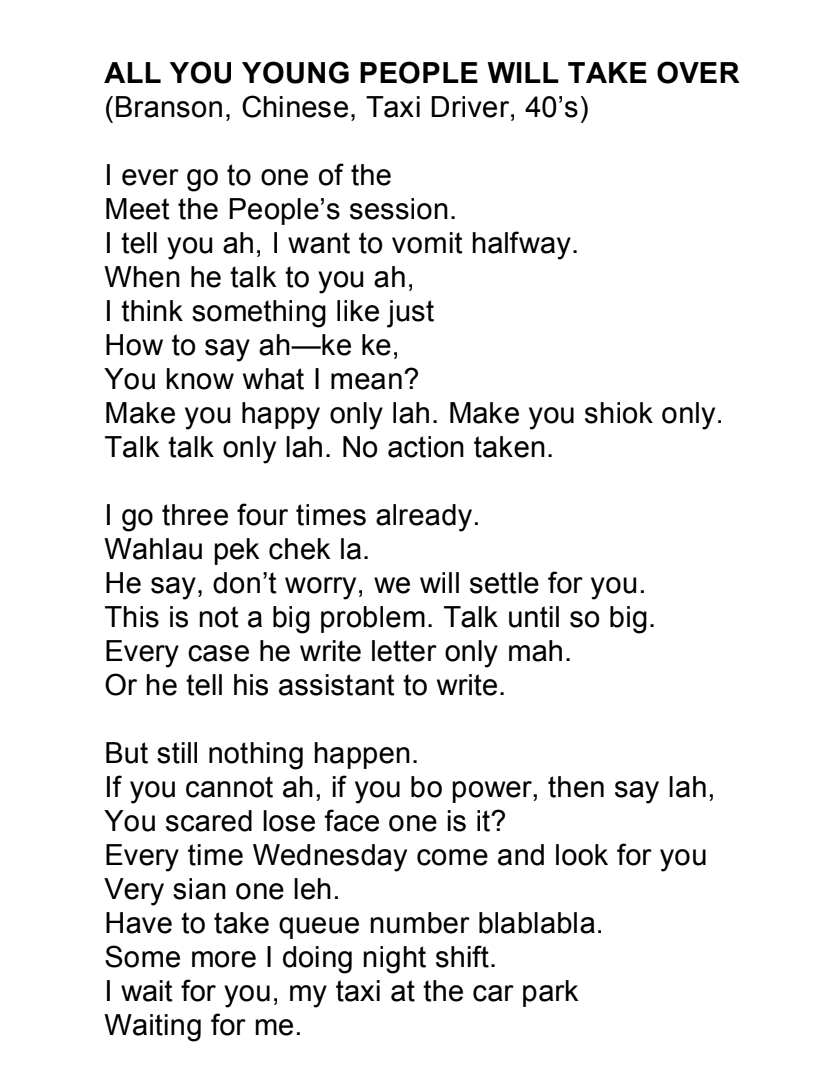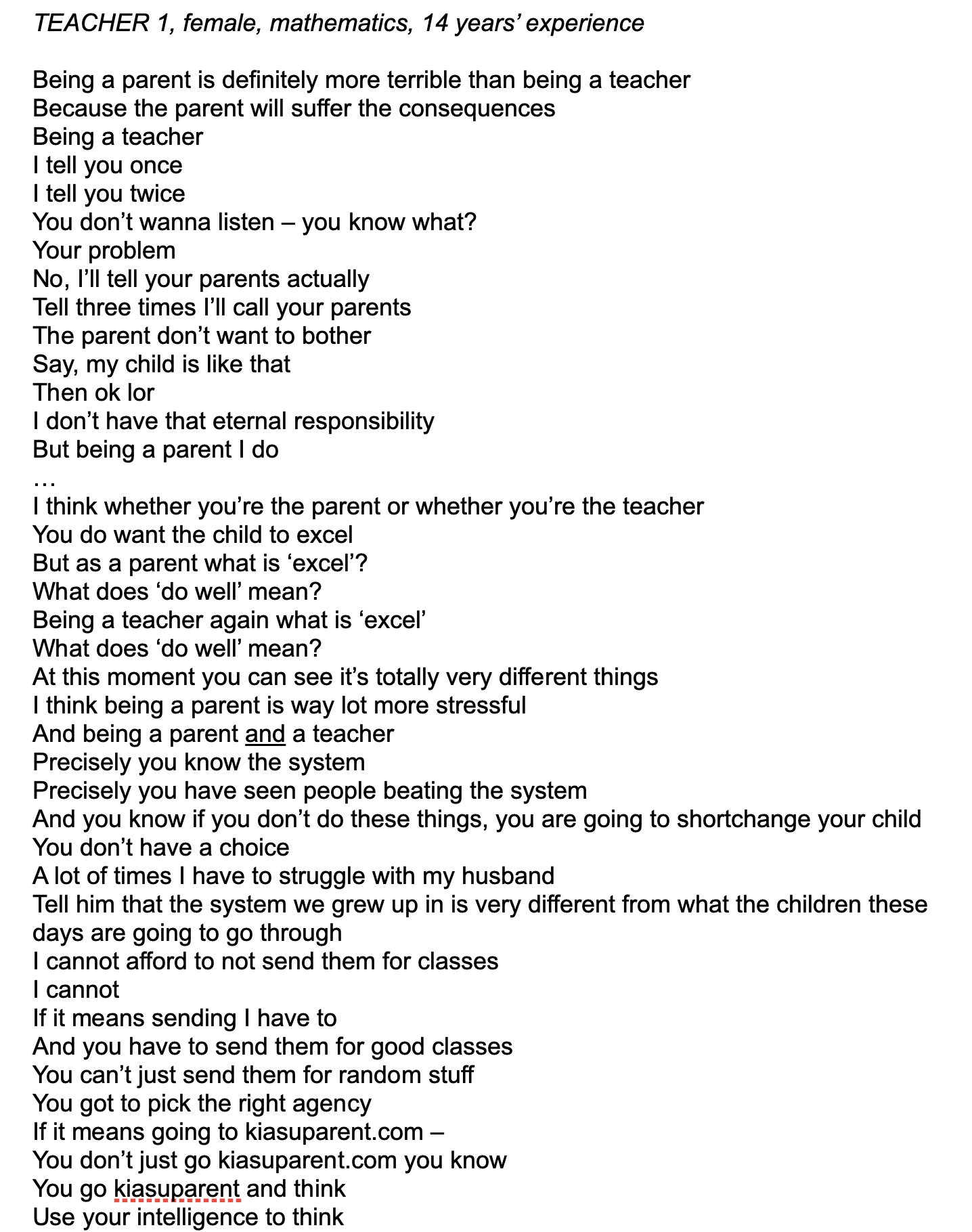
The nation-state of Singapore is a hybrid animal of many tongues. Multicultural and multilingual, it comes as no surprise that in order for communication to happen between all the races, we had to agree upon one language to converse in— English — which is funny to note, because our national language is actually Malay. It is not hard to find the ‘sing’ in Singlish; it is English with a mix of Malay, Tamil and Mandarin, and spiced with other dialects such as Hokkien, Cantonese and Teochew.
This patois is primarily tonal in delivery, with inflections creating the subtext that portray not only its versatility but also its succinctness. It is a musical language. A prime example of this is the ubiquitous ‘lah’ which is peppered at the end of almost every sentence, along with its cousins, ‘lor’, ‘leh’ and ‘meh’. Each soundbite can change the meaning of the sentence and reveal the intentions of the speaker.
That directly resulted in the demise of local TV programs such as Phua Chu Kang and Under One Roof, whose characters spoke Singlish with aplomb. Now, with the academic study of Singlish, and the word ‘Kiasu’ among others, entering the Oxford English dictionary, we are seeing the reemergence of Singlish in local literature once again.
It is not easy as a Singaporean to write objectively of the use of Singlish, mostly because Singlish is used in the everyday. It is hard to deconstruct it and the way it is written (I’m not an English major) because what sounds so natural to a Singaporean in its rules and tone, must now be explained. Why it is “liddat (like that),” in which the only response can be, “liddat (like that) lor,” which grammatically means, just cause it is that way.
The word “Sial” is a Malay word used to emphasise conviction, but can also be used as a punctuation at the end of a sentence to indicate “You stupid dumbass”. But I have heard on occasion Indian and Chinese friends who hang out a lot with their Malay kakis (Friends), use this Malay word despite not being able to speak Malay.
Below are two examples of recent docudramas produced in Singapore that have managed to capture the voice of the characters in text. Verbatim Theatre is not only about keeping faithful to the syntax by which your interviewees speak, but also understanding, as a playwright, when the repetition weighs down the dialogue, and that would mean crafting the verbatim to keep the poetic quality that is inherent in it.
As Anna Deavere Smith, a known Verbatim Theatre practitioner, once said in a rough paraphrase, that she found that sometimes the people she interviewed, spoke in found poems and the playwriting of these interviews was to uncover this poetry.

In the first example by Alfian Sa’at, the play Cooling-Off Day is a direct reference to the one day before Polling Day, which prohibits any kind of election campaigning during that 24-hours to give voters time to reflect.
This play uncovers the political sentiments of normal everyday Singaporeans through interviews, and this is quite radical because it is rare that Singaporeans would be so forthcoming of their political views here.
What also makes this excerpt remarkable is it’s faithfulness to the cadence of the taxi driver’s speech.
Singlish is far from being grammatically correct, but its flexibility in tone can do quite remarkable code-switches. There is a quite natural switch between a quote from someone else (the dialogue/complaint of the Minister) to a quote directly from the character himself. “This is not a big problem. Talk until so big.” Which might be missed, if you had only followed the logic from the beginning of the stanza with “He say”.

In the second example by Marcia Vanderstraaten, the play Micromanage Overwork Exasperate, the tongue-in-cheek renamed acronym for the Ministry of Education, is a docudrama about teachers for teachers. All teachers who are in the service and out of it, are not allowed, legally to speak of their profession. Vanderstraaten wrote the play to give them an outlet.
The use of Singlish in this text is subtle. The grammar is not as mangled. The issue is identifying when that English word has that heavy Singlish accent. An accent can be deconstructed with IPA, but when a reader is unfamiliar with it, it is possible to approach reading this extract in a neutral accent. But then you would lose all the flavours of the piece.
I believe an easy tactic would be to identify when the grammar is broken and then emphasise that out-of-place word. From the first sentence “Being a parent is definitely more terrible than being a teacher.” It informs me that the rest of the text has to be spoken in the Singlish accent, even without seeing words like “lor” in the text.
The use of Singlish stratifies characters and can be used to show power dynamics as well, much like Cockney and the Queen’s English. This means exciting things for writers. Soon we will come to a kind of collective consensus on how to spell certain utterances the more we write and publish. Not that we ever needed permission to write the way we wanted to. But for playwrights, it is doubly important that in our commitment to authenticity and our audience, that we write accurately.
Also on TheatreArtLife:
Projection Design For Theatre: Robert Mallin and “ENRON”
Motherhood And Returning To Work In Entertainment


13+ years with robust experience in various industries such as theatre, TV, finance and civil service, with experience in directing, scriptwriting, production management, and copywriting. Core Member and Founder of Dark Matter Theatrics, which aims to engage people from all walks of life with honest and impactful storytelling. Published writer in prose, poetry and theatre plays. Currently, breaking into screenwriting for TV and film. Experienced in online and print media, in identifying lifestyle trends and developing interesting story angles. My creative work is primarily concerned with human dignity, new myth and the negative imagination.
Read Full Profile© 2021 TheatreArtLife. All rights reserved.

Thank you so much for reading, but you have now reached your free article limit for this month.
Our contributors are currently writing more articles for you to enjoy.
To keep reading, all you have to do is become a subscriber and then you can read unlimited articles anytime.
Your investment will help us continue to ignite connections across the globe in live entertainment and build this community for industry professionals.